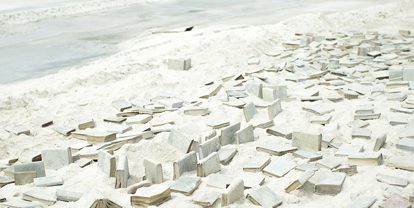Aleph’s Library
Mahsa Aleph
May 26 — June 21, 2017
Of all the secrets only an Aleph was revealed and all that has been said was to expound that Aleph and yet that Aleph was never understood.
Shams-e Tabrizi
Aleph’s Library was first called “Curated Author” and was an expansion of an older work of Mahsa Aleph: Only the Author has Read the Book (2013); a home-cured book that one can neither read nor even page through. The artist has treated the book as one treats decayable food by burying it in salt. Salt crystals have covered the book to the point that not even the title or the author’s name are readable any more.
The verb ‘to cure’ is obviously cognate with the verb ‘to curate’. The noun ‘curate’ refers to those responsible for the care of human souls (cura animarum) or a member of the clergy in charge of curing souls and hence ‘curate’ is a priest or a pastor with canonical responsibility sometimes working under an episcopacy. ‘Cure’ and ‘curate’ both originate from the Latin ‘cura’: cure, care, concern, trouble and so forth. ‘Curation’ too refers to medical treatment and equally to an overseeing of assets of a library or museum. As a verb too curare carried the meanings of ‘caring’ and ‘curing’ and at least since the 18th century the verb ‘to cure’ also means to preserve by salting.
In the same manner the artist has now created a colossal library that not only keeps more than one thousand books [1] cured in an Iranian hyper-saline lake, it also embraces the aforementioned derivatives of cura. Mahsa Aleph is at the same time her own library curator, guardian and carer. The authorship of Aleph who has herself curated numerous authors is then curated by he who writes these sentences. Here the curator plays an undesirable role.
Aleph’s library is the third wall of a high cubic abyss. To reach the books the audience has to stand against the wall and slowly move along the projecting narrow ledge, lest they fall in the chasm. Even if they reach the library the majority of the books are beyond their reach and there is literally nothing to read. The chasm is formed as an empty abyss in the center of the space: a black square surrounded by four illumined ledges. Malevich’s Black Square too was considered the zero point of image, the zero point of form and indeed the radical and profane incarnation of what the Russian theosophy had created around infinite hollow. Treated books render reading, interpretation and/or translation forbidden. Aleph’s curated authors are thus better off murmuring to themselves or as Plato’s Socrates says: “Their works should remain silent, but if you ask them about something, they altogether keep a solemn silence.” [2]
Barbad Golshiri
[1] Aleph’s numeral value in Arabic Abjad and Hebrew is 1 and both could be read as ‘thousand’.
[2] Plato, Phaedrus, James H. Nichols Jr. (Trans.), Cornell University Press (Ithaca 1998), p 86.
